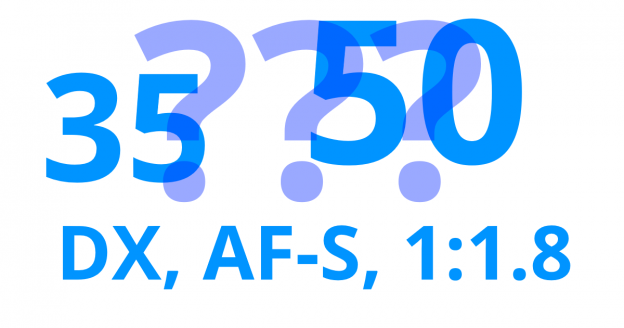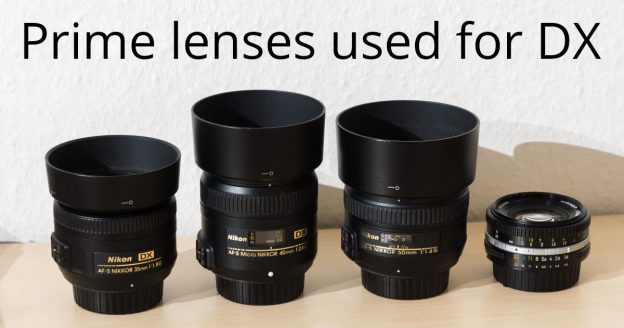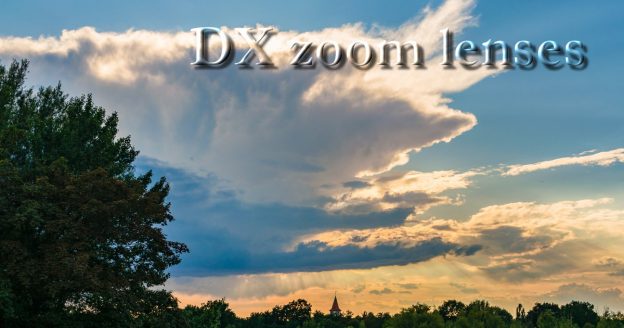This seems to be the most common lens question. Let us not waste any time!
What is DX?
Nikon’s first digital SLR cameras were made for professionals and used a DX-size sensor. Today, many professional cameras use the larger FX format, but DX still exists covering entry-level up to mid-range.
The FX size conforms to classic small-frame film. It is roll film, 35 mm wide. Because of the holes on each side, for sprockets to transport the film, only 24 mm remain for the image. Used for still photography, the film moves sideways. The long side for the image is defined as 36 mm. While considered small frame film then, today’s marketing of digital cameras calls the same size a full frame sensor.
The DX sensor is roughly 24×16 mm, actually a bit smaller. Another label for this size is APS-C, an uncommon consumer film format. Though so-called “APS-C” sensors are slightly smaller than the actual APS-C film frame. Marketing has the tendency to not be very precise. Again, Nikon uses its custom label “DX” instead.
The D in DX probably means digital, F in FX perhaps full frame, or just “F” as in the name for F-mount based film-SLRs, but I never saw an official explanation.
Mechanically and optically, DX cameras can use both DX and FX lenses. But not all cameras support all lens features.
First things first: What does 1:1.8 aperture mean?
Usually, someone posts two 1:1.8 lenses, a 35 mm and a 50 mm and asks which is better.
1:1.8 means the absolute aperture is 1/1.8th of the focal length. Just divide the focal length, 35 or 50 mm, by 1.8!
The 35 mm 1:1.8 lens has 19.4 mm diameter for the lens input. The 50 mm has 27.8 mm input diameter. Both results rounded to one decimal place.
We see that the 50 mm 1:1.8 lens gathers more light in absolute terms, because the diameter for the input of the lens is larger. But it also needs more light, because the magnification is higher. Think about the image taking light from a smaller area, thinning out the light in comparison. That is why the aperture is given as ratio. Ratio to the focal length, shortened as letter f.
No matter what the focal length might be, with the same aperture of “1:1.8” for both lenses, the output brightness is the same as well. The “f-stop number” omits the numerator part, it is just “1.8”.
To reduce the amount of light coming in, one can stop down using aperture blades which form a narrower entrance pupil.

Turn the lens upside down. Play with this lever and you see how changing the aperture works
Actual brightness is also impacted by loss of light within the lens. The more lens elements and simpler lens coating, the greater the internal loss of light. The technical term is “t‑stop”. Letter t for transmission of the light.
And finally, aperture blades are mechanically controlled by most lenses, which means it is not always completely precise. It can be that sometimes the real aperture is a little wider or narrower.
35 or 50 mm, but which lens exactly?
For 1:1.8 aperture, there are two different 50 mm and 35 mm autofocus lenses.
For 35 mm:
- Nikkor AF-S 35 mm 1:1.8G
- Nikkor DX AF-S 35 mm 1:1.8G
The main difference is the output area, the area of projection. The former lens can be used for film and FX sensors. Those lenses have no special designation, there is no “FX” being mentioned in the name. Of course it can be used with your DX camera, too. The 35 mm FX version (which, as just said, has no “FX” in the name) uses a more complex lens design, and is of better build quality. But it is a bit bigger and heavier, and costs a lot more than the DX version.
The DX version of the 35 mm lens only illuminates a DX sensor which is smaller in size than FX. Hence the “DX” label, so you know what you get. As side note, this particular DX 35 mm product almost projects on a film or FX sensor, but not quite. I used it once for film, but got dark corners.
If you have a DX camera, you probably want to get the DX 35 mm lens because it costs considerably less.
For 50 mm:
- Nikkor AF 50 mm 1:1.8D
- Nikkor AF-S 50 mm 1:1.8G
Both lenses are FX, but again these lenses can be mounted on DX cameras. There is a catch: The former lens is “AF” and only focuses on the D7000 series and above because it relies on a motor provided by the camera. On the D5000 and D3000 series, which don’t have this motor, it becomes a manual-focus lens!
The AF-S version has the motor included in the lens itself and offers autofocus on all current Nikon DSRLs. “AF” is for “auto-focus”, and “S” for silent. It is not really silent, but quieter than AF. Talk about marketing …
“D” means that the lens CPU sends the approximate focus distance to the camera which helps with flash, because flash brightness has a considerable falloff depending on the distance.
The “G” caption includes the D feature. In addition, G lenses have no aperture ring anymore. But even if you buy a lens which has an aperture ring, you would set aperture by the camera wheel instead of that lens aperture ring – unless you have a really old Nikon film SLR.
All digital SRLs and many film SLRs since 1996 don’t use the aperture ring, so you are not missing something here. If you got a lens with this ring, set the aperture to the largest f-stop number before mounting, in order to make it usable with the camera’s own aperture mechanism. The camera then automatically opens the aperture to the widest in order to meter, and to autofocus.
The AF-S 50 mm 1.8G lens is newer and uses an improved lens design. It costs a bit more than the 1.8D, but is quieter when focusing and compatible with all DSLRs and not just some.
There are even older Nikkor 50 mm 1.8 lenses, which have no auto-focus at all. I bought one used, because the manual focus feels fantastic on this one. Much smoother than on any modern lens.
But remember!
Neither of these 35 or 50 mm lenses is stabilized. Your zoom lens probably is. Unless you want to freeze motion, you can use that lens stabilization (“VR”, Vibration Reduction) for a longer exposure time in order to get enough light while the image is still sharp.
With the 35 or 50 mm lens you rely on short exposure times to avoid shake blur. In order to get enough light, you have to open the aperture. That gets you more light, too, and more background blur. You might or might not want that blur in the background. If you take a photo of two persons, both should have the same distance to the camera, or at least on of it will be blurry.
Why is 50 mm so cheap, compared?
The flange distance between mount to film or sensor is roughly 46 mm for the Nikon F‑mount. A simple lens cannot be in focus is the flange is longer than the focal length. Luckily the retrofocus design exists, allowing shorter lenses, like 35 mm, to get in focus. This requires additional lens elements.
A Nikon 50 mm lens, considering some 46 mm flange, can use a simple design instead. Or use more lens elements for better image quality. Here is what Nikon did, judged by DXOMark’s sharpness results:
- The 50 mm 1.8 lenses, both D and G, are always FX lenses and very sharp. It makes no sense for Nikon to produce DX versions because the normal, FX-size lenses can be manufactured for a reasonable price anyway, since the design is not too complex.
- The FX 35 mm lens is also very sharp, but correspondingly bulky and expensive.
- The DX 35 mm lens is designed to be affordable and lightweight.
Now what?
Because I have the Nikkor 50 mm 1:1.4G version, I stopped down to 1.8 in order to simulate the 50 mm 1:1.8G lens.
But let us begin with the DX 35 mm 1.8.

Okay, good. The background is a bit blurry. If we would like to get it sharp, we would have to stop down, meaning we would use a higher f-stop number. That means to get a smaller input diameter for the lens. The smaller the input diameter, the more parallel the light rays processed by the lens, thus the sharper the focus over the frame. But decreasing the input size also means to have less light. For our experiment, we just keep the f-stop at 1.8.
Now, from the same position, the 50 mm set to 1.8.

As expected, we get some magnification. Also, the background is much more out of focus, showing noticeably more blur. What if the crop the 35 mm lens image to this frame? Let us try.

Using the right crop, field of view is the same. The depth of field is not – the longer lens, 50 mm, got us more background blur than just doing a crop on the 35 mm lens image. That means, both of these statements are true:
- Using a longer lens results in a narrower field of view
- Cropping an image results in a narrower field of view
But this statement is false:
- Cropping the image increases the focal length
I like to repeat: Crop does not simply act as a multiplier for the focal length, because using an actually longer lens gets you a different image with a shallower depth of field and thus more background blur.
The trap of thinking “35 mm on DX is some 50 mm”
Let me repeat again, cropping does not impact the focal length. It still gets you a narrower field of view. A longer lens also does that, but additionally gets more background blur. There is an even more confusing misconception.
When discussing FX lenses used on a DX camera, you often read something like “on DX, 35 mm is like 50 mm”. This could make you think that depending on being the FX or DX version of a 35 mm lens, you get a different field of view on your DX camera. But that is not the case.
35 mm is 35 mm. Mounted on a DX camera, both the FX and the DX version of the 35 mm lens have the same field of view.
Before we continue, let us summarize what we learned so far:
- The same aperture, like 1:1.8, means the same brightness regardless of focal length
- With stopping down the aperture, we control exposure, but also the depth of field
- To get more background blur with the same aperture, having a longer focal length helps
As alternative to a longer lens, having a wider aperture (lower f-stop number) also helps to get a blurry background. But using instead a longer lens gets you the desired background blur in a more cost efficient way. Of course, the field of view narrows as the lens gets longer.
Perspective
If we prefer to have the ability to get nice background blur, why not just take the 50 mm lens then? Because the field of view is not very wide. Outside you might be able to walk back a few steps, but inside a building you are confined. There is another reason why different lengths are important for different results. Let us first look again at the 50 mm image:

Now, we use the 35 mm lens, and to compensate its wider field of view, we walk towards the sign to get it as large as before.

Since the focus distance is now closer, the background is a bit more out of focus than we had it before with the 35 mm lens. So we learn:
- To get good background blur, move as closely to the subject as the frame allows.
There is another observation here. The sign, photographed with the 35 mm lens, is as large as we had it when we were farther away and used the 50 mm lens. Now look at the trees in the background. They are smaller compared to the 50 mm photo. Why? When we walk towards the foreground, it gets larger more quickly than the background. The proportions change.
If we instead get the foreground larger with using a longer focal length, foreground and background are zoomed by the same rate. This makes the background appear comparatively large, meaning the apparent distance between fore- and background gets compressed.
Result: Walking closer to the subject is not the same as zooming in with the lens, or as cropping the image. The appearance of a photo is not just determined by the field of view – the position of the camera and its relative distance to the subject is very important for the overall photo!
- “Zooming by feet” only works for the foreground. A good photo also cares about the background, even if out of focus. This means sometimes you have to first change your position to get the photo you envision – and then you might need a longer, or shorter lens to get the desired frame.
If you want to make a rather barren place look more beautiful, you might want to get farther away and then zoom in, enlarging background trees to get them big into the picture. Or if you instead want to emphasize the subject, you might instead want to zoom out and get closer, so that the foreground subject appears really prominent compared to the background.
- The longer the focal length, the higher the magnification for the whole image, including the background. Use a longer lens and move away to enlarge the background. Use a shorter lens and move close to the subject for small background proportions.
Different lenses for different uses
Which lens is better now? Regarding build quality, the 50 mm lens feels a bit more solid. But a 35 mm design for F-mount is complicated, having an affordable 35 mm option for DX is great!
The lenses produce different images. If you put a 50 mm lens on a DX camera, it often requires you to be a bit farther way to the subject. Often farther than you would be as a naked-eye spectator. That gets you quite large background objects compared to the foreground, perhaps not looking very natural. On the other hand, it is easier to get background blur.
The 35 mm lens lets you get closer to the subject because the field of view is wider, which results in a more natural appearance of the background scale compared to the subject. In situations you cannot walk backwards as you want because the space is confined, you probably need the wider field of view more than a blurry background.
Long story short: If you can employ it, the 50 mm 1.8 lens will be very welcome. As everyday lens, the 35 mm 1.8 would serve you better because it is wider.


















